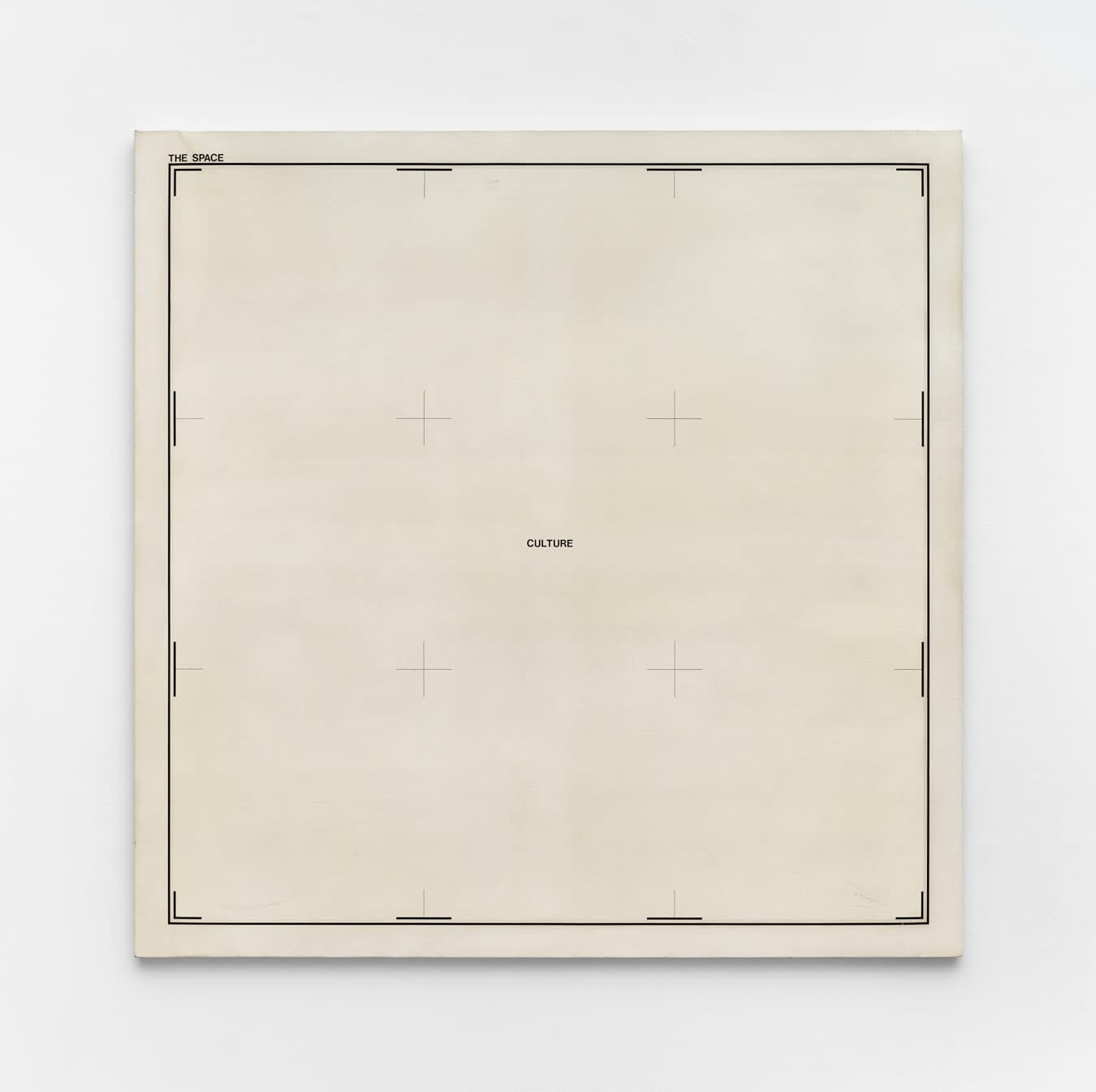Antonio Dias
The space: culture, 1970
acrylic on canvas
150 x 150 x 2.5 cm
59 x 59 x 1 in
59 x 59 x 1 in
Antonio Dias’s work is a political diary, in which the artist reacts to concrete facts, far from any ideological submission. There is no doubt that his medium is language and...
Antonio Dias’s work is a political diary, in which the artist reacts to concrete facts, far from any ideological submission. There is no doubt that his medium is language and that each articulation of signs is a political act. Until the mid-1960s, Antonio Dias fueled a powerful intervention in the Brazilian art scene: He had produced a work marked by “nonsense,” which seamlessly blended self-reflexive operations of conceptual rigor with a crude figurative repertoire, cloaked in debauchery, pessimism, and the carnivalesque. In a context that often welcomed the entry of art into the sphere of information, it was no small thing to promise the direct communication of forms of commercial culture, only to sabotage its semiotic artillery and disappoint the observer.
Some of these operations, in a way, also appeared in the young popular music produced in the country during those years by artists such as Caetano Veloso, Gilberto Gil, Tom Zé or the group “Os Mutantes”, under the aegis of the Tropicália movement — a response to problems of modernization from the mid-twentieth century onwards. In works like these, the expressive elements, which in fact bordered on the formless, were paradoxically stated in the very formal intelligence that animated their making. They pressed, as if from within, the compositional structure of the works — this is a striking aspect in the aesthetic-political imagination of the period.
This purpose is found in another element used by Dias at that time, especially from 1967 onwards, when the grid pattern emerges that will assume a central role from then on. The structure starts to play a leading role; it will not only appear in a productive way, as in the paintings made at that period, occupying almost the entire area of the canvas, but also constituting the object on which Dias will carry out an incessant investigation: the image of the incomplete rectangle and the cruciform elements that permeate his work. These are nonetheless the result of constant debugging exercises in that way, of the quest to extract a fragment of the mesh that can expand indefinitely.
Speaking about these elements — the cross, the rectangular shape and, especially, the checkered structure — mobilizes a vocabulary that has been of great importance within the repertoire of modern art. In the late 1970s, Rosalind Krauss addressed the significance of the grid: “[...] the grid affirms the autonomy of the realm of art. Flattened, geometrized, ordered, it is unnatural, anti-mimetic, anti-real... The grid declares the space of art both autonomous and autotelic.”
In the tumult of 1968, as well as in the concurrent dictatorship in Brazil, freedom was something to be conquered, and its territory was yet to be constituted. Incomplete and open, the grid did not fail to mock the idea of participation in art, so in vogue at that time. In this sense, the work was also a form of institutional critique.
Some of these operations, in a way, also appeared in the young popular music produced in the country during those years by artists such as Caetano Veloso, Gilberto Gil, Tom Zé or the group “Os Mutantes”, under the aegis of the Tropicália movement — a response to problems of modernization from the mid-twentieth century onwards. In works like these, the expressive elements, which in fact bordered on the formless, were paradoxically stated in the very formal intelligence that animated their making. They pressed, as if from within, the compositional structure of the works — this is a striking aspect in the aesthetic-political imagination of the period.
This purpose is found in another element used by Dias at that time, especially from 1967 onwards, when the grid pattern emerges that will assume a central role from then on. The structure starts to play a leading role; it will not only appear in a productive way, as in the paintings made at that period, occupying almost the entire area of the canvas, but also constituting the object on which Dias will carry out an incessant investigation: the image of the incomplete rectangle and the cruciform elements that permeate his work. These are nonetheless the result of constant debugging exercises in that way, of the quest to extract a fragment of the mesh that can expand indefinitely.
Speaking about these elements — the cross, the rectangular shape and, especially, the checkered structure — mobilizes a vocabulary that has been of great importance within the repertoire of modern art. In the late 1970s, Rosalind Krauss addressed the significance of the grid: “[...] the grid affirms the autonomy of the realm of art. Flattened, geometrized, ordered, it is unnatural, anti-mimetic, anti-real... The grid declares the space of art both autonomous and autotelic.”
In the tumult of 1968, as well as in the concurrent dictatorship in Brazil, freedom was something to be conquered, and its territory was yet to be constituted. Incomplete and open, the grid did not fail to mock the idea of participation in art, so in vogue at that time. In this sense, the work was also a form of institutional critique.
